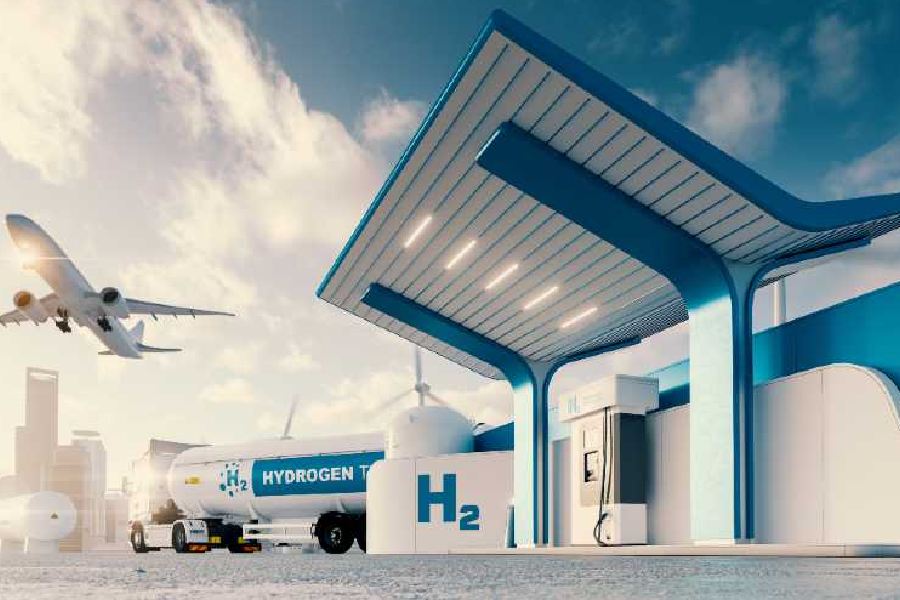‘Net-zero’ is an ideal state where the amount of greenhouse gases released into the earth’s atmosphere is balanced by the amount of GHGs removed. Restricting global warming to 1.5° Celsius above pre-industrial levels requires moving away from fossil fuels, and reducing methane and nitrous oxide emissions from agriculture. Net-zero GHG emissions is not the same as net-zero CO₂ emissions: attaining the former is harder. Net-zero GHG emissions can be achieved with significant negative CO₂ emissions balancing the remaining GHG emissions. As of March 2022, 33 countries and the European Union have set net-zero emissions targets either in law or in a policy document. India has set itself a net-zero target for 2070.
The transition to net-zero CO₂ emissions is underway by generating electricity using renewable resources and gradually electrifying economic sectors. But electrochemistry could usher in the rapid change necessary. In an electrochemical reaction, either the use of direct electric current drives an otherwise non-spontaneous chemical reaction like electrolysis or a potential difference results from a chemical reaction, as in an electric battery. Electrolysis can separate hydrogen and oxygen molecules in water. If the electrical energy that drives electrolysis is non-fossil fuel based, then the hydrogen produced can be the basis for a decarbonised economy.
In January this year, India unveiled its National Green Hydrogen Mission, which aims to provide a comprehensive action plan for establishing a Green Hydrogen ecosystem. This is in line with its ambition of becoming energy-independent by 2047, and achieving net-zero by 2070. India imports over 40% of its primary energy requirements, worth over $90 billion annually.
As the global consensus towards net-zero gathers steam, the demand for Green Hydrogen and its derivatives, Green Ammonia and Green Methanol, is set to rise and boost international trade. To capitalise on this, India is implementing the NGHM through a coordinated approach. The ministry of new and renewable energy will coordinate between various Central and state agencies for this. The current roadmap (until 2030) is divided into two phases. The first phase (till 2024-25) is preparatory, and the second is for implementation, beginning with green fertiliser production.
Some countries have a head-start of decades in this. Nasa began using liquid hydrogen in the 1950s as rocket fuel, and hydrogen fuel cells to power electrical systems on spacecrafts. Several power plants burn hydrogen for electricity generation. It is also possible to run internal combustion engines with hydrogen, but burning hydrogen results in water vapour and nitrogen oxide emissions, and is less efficient than using hydrogen in fuel cells. The cost of automotive fuel cells, despite a steep fall of about 70% since 2008, remains prohibitive. Until the middle of 2021, there were only 43,000 fuel-cell electric vehicles plying globally, mostly passenger cars.
Australia, the United States of America and Spain could lead the Green Hydrogen market by 2030, followed by Canada, Chile, Egypt, Germany, India, Brazil and Morocco. The time is ripe to tap into hydrogen’s potential contribution to a sustainable energy system. In 2019, only three countries had strategies for using hydrogen. Now, at least 20 have released hydrogen strategies. National strategies largely seek to tackle common challenges to scaling up Green Hydrogen production, enhancing hydrogen use across sectors, developing technologies, and crafting enabling policies and regulations. Numerous companies, including major business houses in India, are seeking to take advantage of hydrogen business opportunities. Several projects demonstrating the use of hydrogen-based fuels in rail, shipping and aviation are under development and expected to open up opportunities for driving hydrogen demand.
One hopes these come to fruition in time to arrest runaway global warming. But we need to be mindful that water vapour is also a greenhouse gas, and an increase in atmospheric water vapour exacerbates extreme rainfall events causing widespread damage.
Anamitra Anurag Danda is an environmentalist. Views are personal










